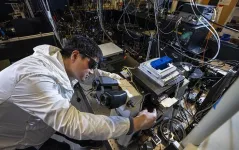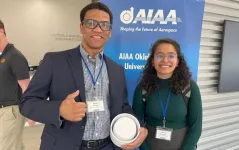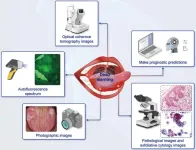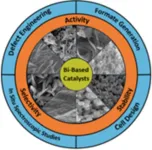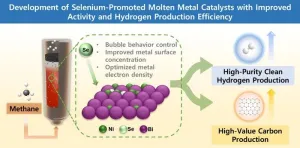(Press-News.org) A research team co-led by Lawrence Berkeley National Laboratory (Berkeley Lab), Columbia University, and Universidad Autónoma de Madrid has developed a new optical computing material from photon avalanching nanoparticles.
The breakthrough – which the team published recently in the journal Nature Photonics – paves the way for fabricating optical memory and transistors on a nanometer size scale comparable to current microelectronics. This approach offers a path toward realizing smaller, faster components for next-generation computers by taking advantage of an optical phenomenon called “intrinsic optical bistability.”
“This is the first practical demonstration of intrinsic optical bistability in nanoscale materials,” said Emory Chan, a staff scientist in Berkeley Lab’s Molecular Foundry and co-lead author on the study. “The fact that we can reproducibly make these materials and understand their unintuitive properties is critical for making optical computers at scale a reality.”
The work is part of Berkeley Lab’s broader push to advance smaller, faster, and more energy-efficient microelectronics with new materials and techniques.
For decades, researchers have sought ways to make a computer that uses light instead of electricity. Materials with intrinsic optical bistability (IOB) – a property that allows a material to use light to switch between two different states, such as glowing brightly or not at all – could serve as components for optical computers. But in previous studies, optical bistability had almost exclusively been observed in bulk materials that were too big for a microchip and challenging to mass produce. And in the few earlier reports of nanoscale IOB, the process was not well understood and was assumed to occur by heating the nanoparticles, which is inefficient and difficult to control.
But now, Chan and the team’s recent study suggests that the new photon avalanching nanoparticles could overcome these challenges in realizing IOB at the nanoscale.
During experiments at the Molecular Foundry, a nanoscale science user facility at Berkeley Lab, the researchers fabricated 30-nanometer nanoparticles from a potassium-lead-halide material doped with neodymium, a rare-earth element commonly used in lasers.
When the nanoparticles were excited with light from an infrared laser, they exhibited a phenomenon known as “photon avalanching,” in which a small increase in laser power results in a giant, disproportionate increase in the light emitted by the nanoparticles. The team first discovered this “extreme nonlinearity” of photon avalanching nanoparticles in their pioneering 2021 paper, which demonstrated that doubling the laser power increased the intensity of the light emitted by 10,000-fold.
In their latest work, the team found that their new nanoparticles were over three times more nonlinear than those original avalanching nanoparticles, “the highest nonlinearities that anyone has ever observed in a material,” Chan said.
To the researchers’ surprise, further experiments in the current study showed that these nanoparticles not only exhibit photon avalanching properties when excited above a given laser power threshold, but they also continue to emit brightly even when the laser power is reduced below that threshold, and only turn off completely at very low laser powers. In other words, these tiny avalanching nanoparticles turned out to be the IOB that had long eluded nanoscientists.
The large difference between these “on” and “off” threshold powers means that there are intermediate laser powers at which the nanoparticles can be either bright or dark, depending only on their history, Chan explained. This ability to switch optical properties without changing the material suggests that the nanoparticles may serve as nanoscale optical memory, particularly volatile random-access memory (RAM).
Seeking the origins of the groundbreaking bistability in these materials, the researchers then used computer models to reveal for the first time that IOB in their nanoparticles arises not from nanoparticle heating, but rather from the extreme nonlinearity of photon avalanching and from a unique structure that dampens vibrations in the particles.
In future studies, the researchers hope to study new applications for optically bistable nanomaterials and find new formulations for nanoparticles with greater environmental stability and optical bistability.
The Molecular Foundry is a nanoscale science user facility at Berkeley Lab.
This work was supported by the Department of Energy’s Office of Science. Additional funding was provided by the Defense Advanced Research Projects Agency (DARPA) and the National Science Foundation.
###
Lawrence Berkeley National Laboratory (Berkeley Lab) is committed to groundbreaking research focused on discovery science and solutions for abundant and reliable energy supplies. The lab’s expertise spans materials, chemistry, physics, biology, earth and environmental science, mathematics, and computing. Researchers from around the world rely on the lab’s world-class scientific facilities for their own pioneering research. Founded in 1931 on the belief that the biggest problems are best addressed by teams, Berkeley Lab and its scientists have been recognized with 16 Nobel Prizes. Berkeley Lab is a multiprogram national laboratory managed by the University of California for the U.S. Department of Energy’s Office of Science.
DOE’s Office of Science is the single largest supporter of basic research in the physical sciences in the United States, and is working to address some of the most pressing challenges of our time. For more information, please visit energy.gov/science.
END
Colorectal cancer (CRC) is the second most commonly diagnosed cancer in China and a leading cause of cancer-related mortality. Despite improvements in treatment, the survival rate remains lower than in Western and other Asian countries due to late-stage diagnosis. Given that CRC typically develops over a prolonged period from precursor lesions, early detection and timely intervention are crucial for improving patient outcomes. However, CRC screening in China faces several challenges, including regional disparities, economic constraints, and limited public awareness. Recent advancements in non-invasive diagnostic tests, innovative imaging techniques, and ...
Aerospace engineering senior Philip Wilson attended an American Institute of Aeronautics and Astronautics (AIAA) conference. Rohit Raut, a senior physics major, presented his work at a nuclear research symposium, and senior biology major Jaden Rankin had the opportunity to feature her research at an entomology conference.
These and other University of Texas at Arlington students were able to showcase their original research at major symposiums thanks to UTA’s expansion of its popular undergraduate research program that provides funding for select students to present at academic conferences.
“At the conference, I presented my work on rotating ...
Oral cancer remains a serious global health concern due to its high morbidity and mortality rates, primarily caused by late-stage diagnosis. The presence of oral potentially malignant disorders (OPMDs) provides an opportunity for early intervention, as these lesions precede the development of oral squamous cell carcinoma. However, the accurate detection and classification of OPMDs remain challenging due to their diverse clinical presentations. Conventional diagnostic methods, including visual examination and histopathological ...
To develop a practical fusion power system, scientists need to fully understand how the plasma fuel interacts with its surroundings. The plasma is superheated, which means some of the atoms involved can strike the wall of the fusion vessel and become embedded. To keep the system working efficiently, it’s important to know how much fuel might be trapped.
“The less fuel is trapped in the wall, the less radioactive material builds up,” said Shota Abe, a staff research physicist at the U.S. Department of Energy’s (DOE) Princeton Plasma Physics Laboratory (PPPL).
Abe is the lead researcher on a new study published in Nuclear ...
The electrochemical reduction of CO2 has been recognized as a promising strategy to convert ambient atmospheric CO2 into valuable products. Bismuth-based catalysts have garnered the widespread attention of researchers due to their cost-effectiveness, low toxicity, and high natural abundance. Significant progress has been made toward enhancing the reactivity of catalyst structures through innovative synthesis techniques and engineering. Advances include the use of flow cells and membrane electrode assembly (MEA) cells to attain high cathodic current densities of over 200 mA cm-2 with superior ...
Researchers in South Korea have developed an advanced liquid metal catalyst incorporating selenium (Se) to enhance the efficiency of turquoise hydrogen production.
Turquoise hydrogen is generated via methane (CH₄) pyrolysis, producing hydrogen while yielding solid carbon as a byproduct, without emitting carbon dioxide (CO₂).
A research team led by Dr. Seung Ju Han at the Korea Research Institute of Chemical Technology (KRICT) has introduced selenium-doped molten metal catalysts (NiBi, CuBi) to significantly enhance methane pyrolysis efficiency. The technology demonstrates ...
A century of fire suppression, combined with global warming and drought, has led to increasingly destructive wildfires in the Western United States. Forest managers use tools like prescribed burns, thinning, mastication, and piling and burning to reduce fuel – live and dead trees, needles and leaves, and downed branches – that can feed intense wildfires. These methods aim to lower fuel levels, reduce crown density, and protect fire-resistant trees, fostering healthier, more resilient forests.
However, prescribed burning efforts haven’t kept up with the rapid buildup of surface fuel, creating a “fire deficit” – the gap between the amount of fuel that has ...
CLEVELAND—Researchers at Case Western Reserve University (CWRU) and University Hospitals (UH) will use state-of-the-art medical technologies they invented—and licensed to Lucid Diagnostics Inc.—to detect esophageal precancer, specifically Barrett’s Esophagus (BE).
BE is a change in the cellular structure of the esophageal lining typically caused by gastroesophageal reflux disease (GERD), also known as heartburn. The goal is to reduce the incidence of esophageal cancer (EAC).
EAC is a rare type of cancer with a high-morality rate—the cause of 2.6% of all cancer ...
Insilico Medicine ("Insilico"), a clinical stage generative artificial intelligence (AI)-driven biotechnology company, today announced the publication of a novel series of orally available covalent CDK12/13 dual inhibitors, as a potential option against refractory and treatment-resistant cancers. Published in the Journal of Medicinal Chemistry (IF=7.2), the study showcases the discovery of compound 12b, a potent, selective, and safe therapy targeting CDK12/13, empowered by Insilico’s proprietary generative AI platforms including PandaOmics and ...
For decades researchers have been exploring how to store data in glass because of its potential to hold information for a long time — eons — without applying power. A special type of glass that changes color in different wavelengths of light, called photochromic glass, holds promise for stable, reusable data storage. Now, researchers have developed a doped photochromic glass that has the potential to store rewritable data indefinitely, according to research published in ACS Energy Letters.
Certain types of ...
